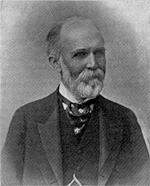The Kelsey Building, 1911
Henry
Cooper Kelsey was a self-made Victorian gentleman, the great-grandson of a
Scots tanner and currier, who was an early resident of Newton, Sussex
County. In 1858, when the young Kelsey
was 21, he took over a Newton store and became active in Democratic
politics. He was appointed postmaster
the next year, serving until the Republicans came into power nationally in
1861. He bought the New Jersey Herald
that summer and settled into journalism and politics. Kelsey, who had married Prudence Townsend the
year he became a publisher, was appointed a judge of the Court of Common Pleas
in 1868, filling the vacancy caused by her father’s resignation. In July of 1870, the governor appointed him
secretary of state.

Henry Cooper Kelsey
He
stayed in the job for 27 years and remained in Trenton for the rest of his
life. Together with Benjamin F. Lee,
clerk of the N.J. Supreme Court for 30 years, and Henry S. Little, clerk of the
Chancery Court, he ran state Democratic politics for three decades ~ choosing
the party candidates for governor and U.S. Senate and a host of lesser offices,
and writing the party platforms. The
Secretary of State, a contemporary wrote, “was a man of the most precise
habits. If you were two minutes late on an appointment with him, he was apt to
close the door in your face.”
From
the time he entered state government until his death 50 years later, he lived
in a suite of rooms at the Trenton House, a hotel on North Warren Street.
Beginning in 1872, when his doctor advised him to go to Europe for his health,
he and Mrs. Kelsey sailed each spring for Europe, returning in the fall.
The
Kelseys had been married for 43 years when she became ill, was hospitalized and
died in 1904. Following his wife’s
death, the childless widower resigned from all social activities. He made large gifts to her church and the
hospital where she died but wanted a more substantial memorial. Although he had no previous connection with
the School of Industrial Arts, which provided night classes to factory workers,
he decided to donate a building to the school, which used rented rooms. Having determined on his gift, he quietly
acquired the land for $19,000, then set about hiring the best architect he
could find.
If Cass Gilbert wasn’t America’s most famous architect when Kelsey made the announcement of his intentions on May 2, 1909, he hadn’t long to wait. He had been Stanford White’s personal assistant at McKim, Mead & White. In 1905, he won the competition to design the New York Customs House and he was hired four years later to work on the Woolworth Building. The 66-story skyscraper was the tallest building in the world when completed in 1913, and remained so for another 20 years. Conspicuous for the beauty of its perpendicular Gothic style, it remains one of Manhattan’s most famous buildings and the cornerstone of Cass Gilbert’s reputation.
Kelsey
met with the architect, saw his gift announced and sailed for Europe, as was
his habit. Gilbert would later explain
that the princely nature of Kelsey’s gift had made him think of princely art
patrons of the Renaissance. He modelled
Mr. Kelsey’s building on the great Florentine Palazzo Strozzi, built in 1489.
The
whole project was intended to memorialize Prudence Townsend Kelsey: A bronze
tablet on the building’s facade is dedicated to her and the first-floor
auditorium was named Prudence Hall. But
her widower also lavished more than $12,000 on the decoration of a single room
on the second floor, a permanent exhibit space for the pieces his wife had
collected on their annual trips to Europe.
Under the pediment of Siena marble and through the double doors ~ the
outer mahogany, the inner satinwood ~ is the second-floor room inscribed: “In
Memoriam Prudence Townsend Kelsey.”
Henry C. Kelsey himself arranged its contents, as a permanent reflection
of the wife he never ceased to mourn.
The extent of his feelings can be gauged by his opening remarks at the
Kelsey Building’s dedication ceremonies:
“When,
on that bitter winter night, now more than seven years ago, the light of my
life went out, all the world seemed dark and cold to me. My heart was chilled, my reason staggered and
I felt that for me the end could not come too soon. But after a period of despair I was aroused
to realize that my own work was not yet done ~ that there were new duties
calling me ~ duty to the community, duty to my friends and hers, and, above
all, the glad duty to honor and exalt her memory in every possible way, for to
her all that I was or had been or am ~ my very existence at my mature age ~ was
due.”
His
Victorian excess of feeling is mirrored in the room, where porcelain cherubs
perch atop framed portraits of the Kelseys; six clocks are stopped at 11:49;
and a number of small calendars are turned permanently to Sunday, January 3,
the time and date of her death in 1904.
Small pictures of Mrs. Kelsey are scattered among the cabinets holding
her belongings, and one shelf displays a sachet envelope, with her calling card
attached. On it is written: “This little
sachet was the last thing I took to Blessed Prude ~ a day or two before
Christmas 1903 (at the hospital). God Bless her soul. O! My darling, darling wife.”
Outside the room, suspended from the building’s facade by lacy ironwork, is a large clock. A great proponent of public clocks (and a man renowned for his own promptitude and his expectation of it in others), Kelsey had two bronze markers attached to the west clock face, permanently recalling his wife’s death at 11:49.